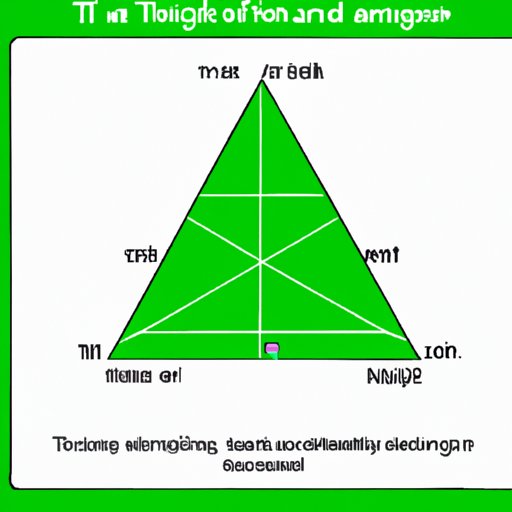Introduction
When it comes to geometry, finding the area of a triangle is a common challenge that many students face. Whether you’re still in school or just looking to refresh your knowledge, this article will help you understand different techniques for finding the area of a triangle. We’ll cover everything from basic formulas to more advanced methods, so you’ll be fully equipped to tackle any triangle problem that comes your way.
Basic Formula for Finding the Area of a Triangle
The most common method for finding the area of a triangle is to use its base and height. The formula for this method is simple:
Area of a Triangle = 1/2 x base x height
To use this formula, first, identify the base and height of the triangle. Then, multiply them together, divide by 2, and you’ll get the area. For example, let’s say the base of a triangle is 6 cm, and the height is 4 cm. To find the area, we’d use the following equation:
Area of a Triangle = 1/2 x 6 cm x 4 cm = 12 cm²
Finding the Area of a Triangle: Base and Height Technique
While the formula itself is simple, there are a few techniques you can use to ensure greater accuracy when using the base and height method. One is to make sure the base and height measurements are perpendicular to each other. This means that the height of the triangle should make a 90-degree angle with the base. If this isn’t the case, you’ll need to use trigonometry to find the height.
Another useful technique is to double-check your measurements. Even slight inaccuracies in your measurements can lead to a significant difference in your final answer. Always measure twice and use the average measurement to ensure greater accuracy.
Using Trigonometry to Find the Area of a Triangle
Trigonometry involves using triangles to solve problems, so it’s no surprise that it can also help find the area of a triangle. To use trigonometry to find the area of a triangle, you’ll need to know the length of at least one side and one angle of the triangle.
Once you have this information, you can use the following formula:
Area of a Triangle = 1/2 x length x height
Keep in mind that the height in this formula represents the distance from the side you know to the opposite vertex. To find the height, you’ll need to use trigonometry.
Using Heron’s Formula to Find the Area of a Triangle
Heron’s Formula is another method for finding the area of a triangle that can be useful when you don’t know the height of the triangle. Instead of relying on the base and height, Heron’s Formula uses the lengths of each side of the triangle to find its area.
The formula is as follows:
Area of a Triangle = √(s(s-a)(s-b)(s-c))
In this equation, ‘a,’ ‘b,’ and ‘c’ represent the lengths of each side of the triangle, and ‘s’ represents the semiperimeter, which can be calculated by adding the length of each side and dividing by 2.
Relationship Between Triangles and Parallelograms
Believe it or not, there’s a relationship between triangles and parallelograms that can make finding the area of a triangle even easier. Essentially, the area of any triangle is half the area of the parallelogram with the same base and height.
This is because a parallelogram can be split into two congruent right triangles, both of which have the same base and height as the original triangle. Since the area of a parallelogram is base x height, the area of the triangle is just half of that.
Coordinate Geometry to Find the Area of a Triangle
If you have the coordinates of each vertex of a triangle, coordinate geometry can be used to find the area. To do this, first, plot the coordinates of each vertex on a coordinate plane.
Next, use the following formula:
Area of a Triangle = 1/2 |(x1(y2-y3) + x2(y3-y1) + x3(y1-y2))|
In this equation, ‘x’ represents the x-coordinate for each vertex, while ‘y’ represents the y-coordinate.
Finding the Area of Irregular Triangles
While regular triangles have a base and height, irregular triangles are a bit more complicated. The best way to approach finding the area of an irregular triangle is to split it into smaller, regular triangles.
To do this, draw a line from one vertex of the triangle to the opposite side, creating two smaller triangles. Then, use one of the methods already discussed (such as the base and height technique) to find the area of each smaller triangle. Finally, add the areas of the two smaller triangles together to get the area of the original triangle.
Conclusion
As you can see, there are many different methods for finding the area of a triangle, each of which has its own advantages and disadvantages. By using these techniques, you’ll be able to solve any triangle problem you encounter with ease. Remember to always double-check your measurements and practice using these methods until you feel comfortable with them. With enough practice, finding the area of a triangle will be a breeze.
